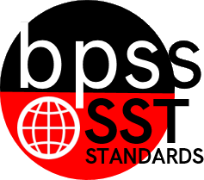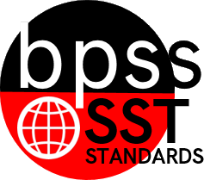4th Grade Social Studies (Archived)
 BPS District Social Studies Standards Book
BPS District Social Studies Standards Book
SST-04 "I can ... statements"
1st Grade Social Studies
2nd Grade Social Studies
4th Grade Social Studies
5th Grade Social Studies
7th Grade Social Studies
8th Grade Social Studies
| Prioritized Benchmarks |
SST-04.1.01
Student Learning Targets:Knowledge Targets
Reasoning Targets
Skills (Performance) Targets
Product Targets
Proficiency Rubric
ResourcesWebsites Helping Your Child With Social Studies Social Studies Alive Resources
Vocabulary
| ||||||||||||||||||||||||||||||||||||||||
SST-04.1.03
Student Learning Targets:Knowledge Targets
Reasoning Targets
Skills (Performance) Targets
Product Targets
Proficiency Rubric
ResourcesWebsites Helping Your Child With Social Studies Social Studies Alive Resources
Vocabulary
| ||||||||||||||||||||||||||||||||||||||||
SST-04.1.04
Student Learning Targets:Knowledge Targets
Reasoning Targets
Proficiency Rubric
ResourcesWebsites Helping Your Child With Social Studies Social Studies Alive Resources
Vocabulary
| ||||||||||||||||||||||||||||||||||||||||
SST-04.2
Narrative for the Important Historical EventsFourth grade students apply their growing academic skills and knowledge to an exploration of North Dakota and its relationships with regional, national, and world communities. Students are beginning to develop a more refined concept of time and can begin to deal with cause-and-effect relationships and decision-making processes, such as identifying problems and considering alternative solutions and their subsequent consequences. Students trace the historical periods, places, people, events, and movements that have led to the development of North Dakota as a state. Calculation Method for StandardsStandards are larger groups of related benchmarks. The Standard Grade is a calculation of all the related benchmarks. Click on the benchmark name below each Standard to access the learning targets and proficiency rubrics for each standard's related benchmarks. | |
SST-04.2.06
Student Learning Targets:Reasoning Targets
Skills (Performance) Targets
Proficiency Rubric
ResourcesWebsites Helping Your Child With Social Studies Social Studies Alive Resources
Vocabulary
| ||||||||||||||||||||||||||||||||||||||||
SST-04.2.07
Student Learning Targets:Knowledge Targets
Reasoning Targets
Proficiency Rubric
ResourcesWebsites Helping Your Child With Social Studies Social Studies Alive Resources
Vocabulary
| ||||||||||||||||||||||||||||||||||||||||
SST-04.2.08
Student Learning Targets:Reasoning Targets
Proficiency Rubric
ResourcesWebsites Helping Your Child With Social Studies Social Studies Alive Resources
Vocabulary
| ||||||||||||||||||||||||||||||||||||||||
SST-04.2.09
Student Learning Targets:Product Targets
Proficiency Rubric
ResourcesWebsites Helping Your Child With Social Studies Social Studies Alive Resources
Vocabulary
| ||||||||||||||||||||||||||||||||||||||||
SST-04.3
Narrative for the Economic ConceptsFourth grade students apply their growing academic skills and knowledge to an exploration of North Dakota and its relationships with regional, national, and world communities. Students are beginning to develop a more refined concept of time and can begin to deal with cause-and-effect relationships and decision-making processes, such as identifying problems and considering alternative solutions and their subsequent consequences. These skills and concepts must be related to students’ lives and should be presented in a wide variety of resources and hands-on-activities. The Economics standard helps students study and compare the characteristics of North Dakota changing economy in the past and present. Calculation Method for StandardsStandards are larger groups of related benchmarks. The Standard Grade is a calculation of all the related benchmarks. Click on the benchmark name below each Standard to access the learning targets and proficiency rubrics for each standard's related benchmarks. | |
SST-04.3.04
Student Learning Targets:Knowledge Targets
Proficiency Rubric
ResourcesWebsites Helping Your Child With Social Studies Social Studies Alive Resources
Vocabulary
| ||||||||||||||||||||||||||||||||||||||||
SST-04.4
Narrative for the Government and CitizenshipFourth grade students apply their growing academic skills and knowledge to an exploration of North Dakota and its relationships with regional, national, and world communities. Students are beginning to develop a more refined concept of time and can begin to deal with cause-and-effect relationships and decision-making processes, such as identifying problems and considering alternative solutions and their subsequent consequences. These skills and concepts must be related to students’ lives and should be presented in a wide variety of resources and hands-on-activities. In the fourth grade, students identify key people, places and events that have shaped their state and region. They learn to explain how changes have affected people and communities. In learning about North Dakota goverment and politics, tudents describe the components and characteristics of North Dakota'sconstitutional form of government; explain the levels and three branches of Indiana’s government; understand citizenship rights and responsibilities; investigate civic and political issues and problems; use inquiry and communication skills to report findings in charts, graphs, written and verbal forms; and demonstrate responsible citizenship by exercising civic virtues and participation skills. Calculation Method for StandardsStandards are larger groups of related benchmarks. The Standard Grade is a calculation of all the related benchmarks. Click on the benchmark name below each Standard to access the learning targets and proficiency rubrics for each standard's related benchmarks. | |


 Standard 1:
Standard 1: